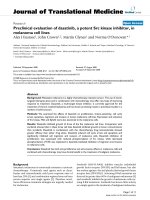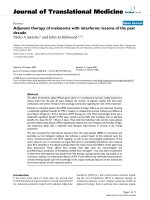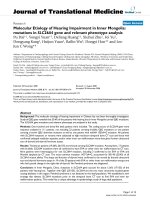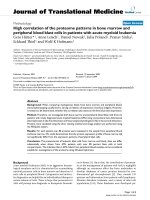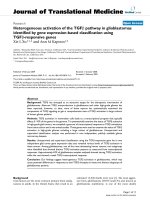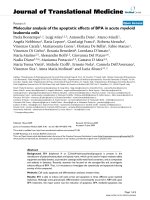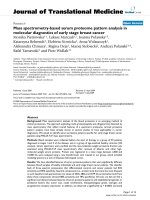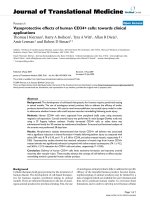Báo cáo hóa học: " AFM-assisted fabrication of thiol SAM pattern with alternating quantified surface potential" pdf
Bạn đang xem bản rút gọn của tài liệu. Xem và tải ngay bản đầy đủ của tài liệu tại đây (351.68 KB, 5 trang )
NANO EXPRESS Open Access
AFM-assisted fabrication of thiol SAM pattern
with alternating quantified surface potential
Bradley Moores
1
, Janet Simons
2
, Song Xu
3
, Zoya Leonenko
1,2*
Abstract
Thiol self-assembled monolayers (SAMs) are widely used in many nano- and bio-technology applications. We report
a new approach to create and characterize a thiol SAMs micropattern with alternating charges on a flat gold-
coated substrate using atomic force microscopy (AFM) and Kelvin probe force microscopy (KPFM). We produced
SAMs-patterns made of alternating positively charged, negatively charged, and hydrophobic-terminated thiols by
an automated AFM-ass isted manipulation, or nanografting. We show that these thiol patterns possess only small
topographical differences as revealed by AFM, and distinguished differences in surface potential (20-50 mV),
revealed by KPFM. The pattern can be helpful in the development of biosensor technologies, specifically for
selective binding of biomolec ules based on charge and hydrophobicity, and serve as a model for creating surfaces
with quantified alternating surface potential distribution.
Background
Thiol self-assembled monolayers (SAMs) are promising
for many nano- and bio-technology appl ications as they
offer a reliable method to produce surfaces with desir-
able properties. These properties can be used for specific
and non-specific binding of biomolecules and nanoparti-
cles and, therefore, can serve as useful templa tes for
nano- and micro-fabrication. The first systematic study
of thiol chemicals was reported by Zisman and co-
authors [1], and has since been investigated by many
resear chers, including a detailed review by Chechik et al
[2]. SAMs can be defined a s “molecular assemblies that
are formed spontaneously be the immersion of an
appropriate substrate into a solution of an active surfac-
tant in an organic solvent” [3]. Thiols are a perfect type
of such surfactant as they consist of a surface-active sul-
fur group that binds to the metal surface, a hydrocarbon
chain of various lengths that defines the packing of the
monolayer, and a functional group at the end that deter-
mines the functional properties of the formed SAM film.
When metallic surfaces such as gold, platinum, or silver
are exposed to thiols dissolved in organic solvent, a
bond is formed between the thiol’sactivesulfurgroup
and metal atoms of the surface, which is characterized
by a shared pair of electrons. Uniform monolayer cover-
age can be created on flat metallic surfaces using proce-
dures empirically determined for each thiol type,
involving factors such as incubation time, solvent, a nd
concentration [4,5].
With the invention of scanning probe microscopy and
other nanoscale characterization techniques, much interest
has been created in nanoscale fabrication for nanoelectro-
nics and biosensing. The advantage of sensing on the
nanoscale using miniaturized devices created a demand in
producing thiol SAMs of a repeated pattern, which can be
used as biosensing platforms. Many nanopatterning tech-
niques require electron-beam or photo-lithography in
vacuum environments [6], using a polymer mask [7,8], or
stamping approaches [9], and cannot produce patterns on
the nanoscale. The atomic force microscopy (AFM)-based
nanopatterning technique simply involves using an atomic
force microscope, where the AFM probe is used as a sharp
stylus to scratch the thiols from the surface. The force
applied by the AFM probe can easily disturb the sulfur
bond between the thiols and metal surface. This approach
has been demon strated by producing simple defects in
thiol monolayers [10]. This opened the development of a
new nanografting method for patterning SAMs with nan-
ometer precision [10]. In this study, we used the new
nanografting method to produce a pattern by mechanically
substituting one thiol with another using an AFM probe in
the solution of the second thiol. The scratched squares
* Correspondence:
1
Department of Physics and Astronomy, University of Waterloo, 200
University Avenue West, Waterloo, ON N2L 3G1, Canada.
Full list of author information is available at the end of the article
Moores et al. Nanoscale Research Letters 2011, 6:185
/>© 2011 Moores et al; l icensee Springer. This is an Open Access article distributed under the terms of the Creative Commons Attribution
License ( which permits unre stricted use, distribution, and reproduction in any medium,
provided the original work is properly cited.
produced by the AFM probe were immediately filled by
the second thiol present in solution due to the higher che-
mical concentration. This procedure makes it possible to
create an alternating charge pattern composed of two dif-
ferent thiols. We u sed the AFM to charac terize surface
morphology and Kelvin probe force microscopy (KPFM)
to characterize the surface potential of the produced
pattern.
Results and discussion
Nanografting
Uniform surface coverage wit h one thiol was created by
incubating a gold surface for 24-72 h in this thiol solu-
tion. After incubation, the sample was exposed to a sec-
ond thiol solution in an AFM liquid cell. The AFM
probe, with a spring constant of 5 N/m, was inserted into
the liquid cell an d was used to scratch squares of defined
dimension,varyingfrom10by10nmto10by10μmin
contact mode. The forc e applied was just high enough to
remove thiol molecules from the surface (approx imately
between 10 and 50 nN), thus leaving the gold unda-
maged. We have performed scratching at high speeds
(10 lines/s) in order to reduce therma l drift and decrease
the time required to create a pattern. The number o f
lines per square depends on the tip geometry, but we
found for 10 μm
2
squares at least 512 lines were required.
The scratched squares produce d by the AFM probe were
immediately filled by thiol 2 present in solution due to
the higher concentration of this thiol. The second t hiol
must have a higher affinity for the metallic surface to
replace the first thiol removed from the surface by AFM
probe. This process makes it possible to create an alter-
nating charge pattern, co mposed of t wo different thiols.
AFM and KPFM were used to characterize the pattern in
terms of topography and surface potential.
We first incubated a solution of CH
3
-terminated thiol
molecules on gold-coated glass for 24 h. Figure 1a
showsanAFMtopographyimageofthisthiolSAMin
air. We applied a three-step nanografting method [11]
to produce a pattern. First, AFM was used to image a
previously formed monolayer (matrix SAM) in a solu-
tion with another thiol (COOH-terminated thiol). Sec-
ond, the tip was positioned into a selected spot to start
a programmed scrat ching of defined areas. The scratch-
ing was performed with a higher load than the threshold
for t hiol 1 (CH
3
-terminated) displacement [12]. During
the scratching, the AFM probe removed matrix thiol 1
and produced bare gold squares exposed to thiol 2
(COOH-terminated) solution (nanoshaving) [13].
Surface potential of thiol SAM pattern
Figure 2a shows AFM topography image of the two-
thiols pattern, created by substituting thiol 1 (CH
3
-
terminated thiol) with thiol 2 (COOH-terminated thiol).
Topography does not show much contrast as the two
thiols do not differ significantly in height. The cross-
section plot for topography image shows flat profile,
with exception of few impurities. Figure 2b shows a sur-
face potential map, obtained with KPFM and reveals a
pronounced difference (20 mV) in surface potential on
the border of two thiols (cross-section plot, Figure 2d).
Figure 1 AFM topography of CH
3
thiol SAM and pattern.AFM
topography of (a) a uniformly covered CH
3
thiol surface, and (b) a
nanopattern shaved into a thiol surface exposing gold surface.
Moores et al. Nanoscale Research Letters 2011, 6:185
/>Page 2 of 5
Conclusions
In summary, we showed that thiol SAM pattern with
chemical functionality and desired surface potential dif-
ferences can be created using AFM-based nanografting
method. In a ddition, we demonstrated for the first time
that small differences in surface potential maps asso-
ciated with organic thiol patterns can be resolved by
KPFM in mV range. Such patterns with controlled dif-
ferences in surface potential can be usef ul in nano- and
bio-technology applications and to study interactions of
Figure 2 AFM and KPFM of CH
3
/COOH thiol pattern. Nanopattern (a) topography and (b) KPFM produced using CH
3
and COOH thiols. (c,d)
show cross-sections of the topography and KPFM, respectively.
Moores et al. Nanoscale Research Letters 2011, 6:185
/>Page 3 of 5
charged species, such as nanoparticles and macromole-
cular ions with non-uniformly charges surfaces.
Methods
Chemicals and sample preparation
Decanethiol, cysteamine hydrochloride, 3-mercaptopro-
pionic acid, and HPLC grade ethanol were purchased
from Sigma- Aldrich Chemical C o. (St. Louis, MO,
USA). These chemicals produce CH
3
,NH
2
, and COOH-
terminated surfaces, respectively. All chemicals were
used as received with no further purification. Thiols
were dissolved in ethanol at 5 mM concentration.
Thiol SAM preparation
Gold-coated mica slides were purchased from Agilent
Technologies, Inc. (Santa Clara, CA, USA). Bef ore use,
the se gold surfaces were glued to clean glass cover slips
using Epo-Tek 377 glue from Epo-Tek, Inc. (Billerica,
MA, USA), which was cured at 150°C for 1 h [14]. The
mica slide was removed from the “sandwich” substrate,
leaving the glass with attached gold thin film, revealing
the atomically flat gold side. The exposed gold was
imaged to confirm atomically flat topography. The gold
surfaces were the n incubated in an appropriate 5 mM
thiolsolutioninethanolfor24-72htoobtainuniform
SAM surface coverage.
Atomic force microscopy
AFM uses a sharp probe over a sample surface and allows
for imaging the topographical features at the nanoscale.
Two common modes of operation are contact mode and
intermittent contact mode. Thiol-modified surfaces were
imaged in intermittent contact mode with a JPK Nanowi-
zard II atomic force microscope. In intermittent contact
mode, the tip is oscillated at the resonant frequency of
the cantilever, and a feedback loop maintains constant
amplitude over the entire image to insure the gentle ima-
ging conditions. The probes used were Nanoworld NCH
tips with a resonant frequency of approximately 338 kHz
and 42 N/m spring constant. In contact mode of imaging,
the tip usually lightly touches the surface and is moved
up and down with the topographical features of the sam-
ple. Wit h increased force the pr obe can interact strongly
with the surfaces and remove soft matter from the sur-
face. This approach wa s used for nanografting. Auto-
mated patterning was achieved by programming the JPK
AFM imaging software to scratch a square of defined size
and then move to the next defi ned location . Alternating
this process produces the pattern with the size of few
nm
2
to few μm
2
.
Kelvin probe force microscopy
KPFM is an extension of AFM that provides the ability
to map the surface potential in addition to imaging
sample topography [15-17]. KPFM measures the surface
potential by eliminating the electrostatic interactions
between the tip and sample by applying a DC bias. This
DC bias is tuned by a feedback loop that monitors
mechanical oscillations induced in the tip due to an AC
voltage (1 V) applied to the tip or sample. KPFM images
were recorded using lift mode (also known as hover
mode) oper ation. In lift mode KPFM, the topography of
thesampleismeasuredduringthetracescanwithout
an applied potential. During the retrace of the same
line, the tip follows the topography measured during the
trace pass but offset 50 nm above the surface, and an
AC and DC voltage is applied between the tip and sam-
ple to nullify the electrostatic interactions. Increasing
the tip-sample separation by 50 nm eliminates the possi-
bility of cross talk between the topography and surface
potential measurements.
Surface potential images were recorded in air using
Nanoworld NCH cantilevers with a JPK Nanowizard II
AFM in a hover mode KPFM. The gold substrates were
grounded to eliminate sample charging.
Abbreviations
AFM: atomic force microscopy; KPFM: Kelvin probe force microscopy; thiols:
SAMs (self-assembled monolayers).
Acknowledgements
The authors acknowledge technical support from JPK Instruments, Germany,
and Agilent Technologies, USA. The authors acknowledge financial support
from Natural Science and Engineering Council of Canada (NSERC), Canadian
Foundation of Innovation (CFI), Ontario Research Fund (ORF), as well as
Waterloo Institute for Nanotechnology (WIN) Graduate Scholarship Award to
B. Moores.
Author deta ils
1
Department of Physics and Astronomy, University of Waterloo, 200
University Avenue West, Waterloo, ON N2L 3G1, Canada.
2
Department of
Biology, University of Waterloo, 200 University Avenue West, Waterloo, ON
N2L 3G1, Canada.
3
Agilent Technologies, 4330 W. Chandler Blvd. Chandler,
AZ 85226, USA.
Authors’ contributions
BM and JS carried out the thiol SAM preparation and nanografting
experiments, participated in the manuscript draft preparation. BM carried out
KPFM imaging. SX participated in nanografting experiments and participated
in the manuscript draft preparation. ZL conceived of the study, participated
in its design and coordination and finished the final draft of the manuscript.
All authors read and approved the final manuscript.
Competing interests
The authors declare that they have no competing interests.
Received: 12 November 2010 Accepted: 1 March 2011
Published: 1 March 2011
References
1. Bigelow WC, Pickett DL, Zisman WA: Oleophobic monolayers. 1. Films
adsorbed from solution in non-polar liquids. J Colloid Sci 1946, 1:513-538.
2. Chechik V, Stirling CJM: Gold-thiol self-assembled monolayers. In The
Chemistry of organic derivatives of gold and silver. Volume chapter 15. Edited
by: Patai S, Rappoport Z. Hoboken NJ: John Wiley 1999:561-640.
3. Ulman A: An Introduction to Ultrathin Organic Films: From Langmuir-Blodgett
to Self-Assembly New York: Academic Press; 1991.
Moores et al. Nanoscale Research Letters 2011, 6:185
/>Page 4 of 5
4. Strother T, Hamers RJ, Smith LM: Covalent attachment of
oligodeoxyribonucleotides to amine-modified Si (001) surfaces. Nucleic
Acids Res 2000, 28:3535-3541.
5. Boon EM, Salas JE, Barton JK: An electrical probe of protein-DNA
interactions on DNA-modified surfaces. Nat Biotechnol 2002, 20:282-286.
6. Baralia GG, Pallandre A, Nysten B, Jonas AM: Nanopatterned self-
assembled monolayers. Nanotechnology 2006, 17:1160-1165.
7. Chen W, Ahmed H: Fabrication of 5-7 nm wide etched lines in silicon
using 100 keV electron-beam lithography and PMMA resist. Appl Phys
Lett 1993, 62:1499-1501.
8. Vieu C, Carcenac F, Pépin A, Chen Y, Mejias M, Lebib A, Manin-Ferlazzo L,
Couraud L, Launois H: Electron-beam lithography: resolution limits and
applications. Appl Surf Sci 2000, 164:111-117.
9. Kumar A, Abbott NL, Kim E, Biebuyck HA, Whitesides GM: Patterned self-
assembled monolayers and meso-scale phenomena. Acc Chem Res 1995,
28:219-226.
10. Liu GY, Xu S, Qian Y: Nanofabrication of self-assembled monolayers using
scanning probe lithography. Acc Chem Res 2000, 33:457-466.
11. Xu S, Liu GY: Nanometer-scale fabrication by simultaneous nanoshaving
and molecular self-assembly. Langmuir 1997, 13:127-129.
12. Liu GY, Salmeron MB: Reversible displacement of chemisorbed n-alkane
thiol molecules on Au(111) surface: an atomic force microscopy study.
Langmuir 1994, 10:367-370.
13. Xu S, Laibinis PE, Liu GY: Accelerating the kinetics of thiol self-assembly
on gold-a spatial confinement effect. Am Chem Soc 1998, 120:9356-9361.
14. Wagner P, Hegner M, Guntherodt HJ, Semenza G: Formation and in situ
modification of monolayers on template-stripped gold surfaces.
Langmuir 1995, 11:3867-3875.
15. Nonnenmacher M, O’Boyle MP, Wickramasinghe HK: Kelvin probe force
microscopy. Appl Phys Lett 1991, 58:2921-2923.
16. Zerweck U, Loppacher C, Otto T, Grafstrom S, Eng LM: Accuracy and
resolution limits of Kelvin probe force microscopy. Phys Rev B 2005,
71:125424-12543.
17. Moores B, Hane F, Eng L, Leonenko Z: Kelvin probe force microscopy in
application to biomolecular films: frequency modulation, amplitude
modulation, and lift mode. Ultramicroscopy 2010, 110:708-711.
doi:10.1186/1556-276X-6-185
Cite this article as: Moores et al.: AFM-assisted fabrication of thiol SAM
pattern with alternating quantified surface potential. Nanoscale Research
Letters 2011 6:185.
Submit your manuscript to a
journal and benefi t from:
7 Convenient online submission
7 Rigorous peer review
7 Immediate publication on acceptance
7 Open access: articles freely available online
7 High visibility within the fi eld
7 Retaining the copyright to your article
Submit your next manuscript at 7 springeropen.com
Moores et al. Nanoscale Research Letters 2011, 6:185
/>Page 5 of 5
